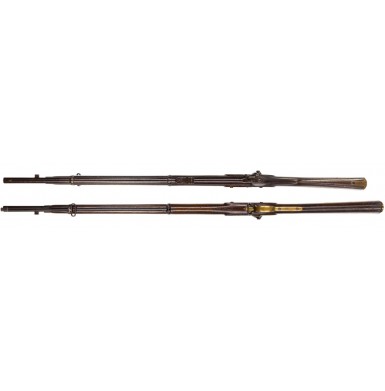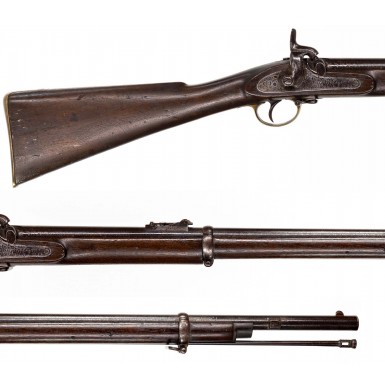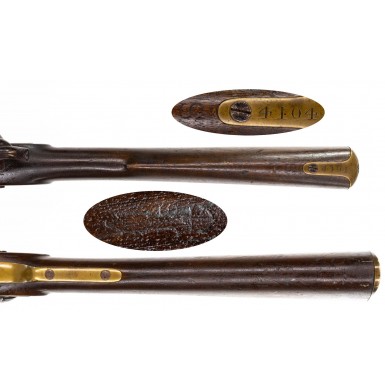Confederate Numbered Pattern 1858 Naval Rifle by Bentley & Playfair
- Product Code: FLA-3890-SOLD
- Availability: Out Of Stock
-
$6,995.00
This is very nice example of a rarely encountered Confederate imported Pattern 1858 Enfield Naval “Short Rifle”. The gun bears the highly desirable Confederate J S / {ANCHOR} viewer’s mark behind the triggerguard and has the Confederate inventory number 4104 engraved on the tang of the brass buttplate. The “furnisher’s mark” S is stamped clearly in the top of the stock comb, forward of the buttplate tang.
During 1861 and 1862, the Confederacy entered into several contracts for the delivery of “Enfield” pattern percussion muzzleloading long arms of all varieties. Many of these contracts are well documented within the papers of Confederate General Colin McRae, which reside in the collection of the South Carolina Relic Room & Military Museum, in Columbia, SC. While the purchases concentrated on Pattern 1853 Enfield Rifle Muskets for use by the Confederate infantry, a number of “short rifles” were also procured, as well as a much smaller number of Enfield cavalry and artillery carbines. Confederate documents reveal that one of the early orders included 30,000 Pattern 1853 “Long Enfields” which were obtained from Sinclair, Hamilton & Company, as well as 10,000 “short rifles” of varying patterns. The short rifle order appears to have been serviced by multiple vendors, with recovered documents revealing that Sinclair, Hamilton & Company delivered about 6,600, William Grazebrook delivered around 2,300, and S. Isaac, Campbell & Company delivered just fewer than 1,000. The 40,000 guns from these Confederate central government contracts, 30,000 long and 10,000 short Enfields, are the ones that are found with the both the J S / {ANCHOR} viewer’s mark and engraved Confederate inventory number markings. The “Long Enfields” were numbered in three series, from 1-10,000, 1-10,000 A and 1-10,000 B. The short rifles were simply serialized in the 1-10,000 range, without a series letter suffix. The short rifles were mostly a mixture of standard British Military Pattern 1856 and Pattern 1856 No 2 (sometimes referred to as the Pattern 1858 “Bar on Band”) iron mounted rifles, as well as non-standard, commercial brass mounted Pattern 1856 and Pattern 1856 No 2 rifles. A handful of the brass mounted Pattern 1858 Naval Rifles, and a very few Pattern 1860 and Pattern 1861 rifles (both iron and brass mounted) were also purchased.
According to the Summary Statement of Overseas Purchases, prepared by the Confederate Secretary of War on February 3, 1863, a total of 9,715 Enfield “Short Rifles” had been purchased by that date.
The Pattern 1858 Naval Rifle was equipped with a bayonet lug on the right side of the barrel, near the muzzle much like the other Enfield short rifles. However, this one was intended to accommodate a special Pattern 1859 “Cutlass Bayonet”, an extra-large saber style bayonet with an iron basket hilt that allowed the bayonet to do double duty as a boarding cutlass. While the Confederate Navy did purchase 1,000 Pattern 1858 Naval Rifles with cutlass bayonets which were also marked with the “JS/Anchor” inspection stamp and with engraved inventory numbers from 1 to 1000, the Confederate Army did not want to use the overly large, heavy, and cumbersome cutlass bayonets, preferring instead the standard Pattern 1856 semi-Yataghan blade saber bayonet. It appears that Caleb Huse purchased some 700 Pattern 1858 Naval Rifles from the firm of Sinclair, Hamilton & Company, in two groups. The first order is dated 11 June 1861 and was for 200 rifles with an additional 500 rifles purchased on 27 June 1861. The rifles are referred to as “Sea Service Rifles – New Service Pattern”, but the order specifically notes that the guns should be: “fitted with the same bayonets as the Short rifles”. It is believed that these first 200 Naval Rifles were probably shipped via the blockade-runner Gladiator. According to the limited surviving manifests and bills of lading that have been recovered that include short rifles in blockade runner cargoes, we know that at least 700 “short rifles” were part of the cargo of the famous blockade runner Gladiator and at least some short rifles were recovered from the wreck of the blockade runner Modern Greece.
The Pattern 1858 Enfield Naval “Short Rifle” was an improved version of the standard British military land service short rifle of the era the Pattern 1856 Rifle. Like the Pattern 1856 Rifle, the Pattern 1858 had a 33” barrel, with a .577 caliber bore. The “Naval” rifle had a heavier barrel than that Pattern 1856 Army version and was rifled with 5-grooves instead of the usual 3-grooves used in the P1856 rifle and the P1853 rifle musket. The bore also had a faster rate of twist, at 1 turn in 48”, rather that 1 turn in 72” that was the current standard. The 5-groove, faster twist rifling proved quite effective, and with the adoption of the Pattern 1860 Short Rifle by the British Army, 5-groove rifling at a rate of 1:48 combined with a heavier barrel became the norm for all future Enfield pattern percussion short rifles. The rear sights of the rifles were graduated to 1,100 yards (rifle musket sights were graduated to 900 or 1,000 yards) and were set just behind the rear barrel band; further forward on the barrel than the sights used on the rifle musket. This placed the sight in a more advantageous place, allowing the shooter to focus on it more easily. It is worth noting that the change in rifling, rate of twist and sight placement were all the result of experimentation performed by Colonel Crawford Hay, the commandant of the British Military School of Musketry at Hythe. While the Pattern 1856 rifle had its rear sling swivel attached to a lug, screwed into the rear of the extended iron triggerguard tang, the Naval rifle had the swivel mounted on the front of the brass triggerguard, as it was with the rifle musket and utilized the same short tang brass triggerguard as the musket length weapon. In both cases, the upper swivel was attached to the upper barrel band. As with the Pattern 1853 rifle muskets (and all Enfield pattern arms of the time), the rifles had rust blued barrels and bands, and color case hardened locks and hammers. The furniture (triggerguard, butt plate, stock escutcheons, nose cap, etc.) of the “iron mounted” rifles was made of iron rather than brass and was color casehardened or blued. In the case of “brass mounted” guns, this furniture was of brass, as found on the rifle muskets. Due to the difficulty of engraving a number in the case hardened buttplate tang, the iron mounted rifles that were inventory numbered were stamped with their inventory numbers in the wood of the stock belly, while the brass mounted rifles had the numbers engraved on the tops of the butt plate tangs. The matching inventory number was also engraved on the forward portion of the ramrod and on the reverse pommel cap of the matching saber bayonets.
Short rifles were lighter and handier than rifle muskets and were preferred for use not only by Confederate infantry that functioned as skirmishers and sharpshooters, but by Confederate cavalry that tended to operate as mounted infantry, rather than as traditional light or heavy cavalry. Confederate cavalry commanders J.E.B. Stuart and Nathan Bedford Forrest were both proponents of issuing short rifles to their cavalry troopers. Short rifles with saber bayonets are known to have been issued to Confederate infantry regiments serving in Kershaw’s South Carolina Brigade, the 10th, 16th, 18th & 51stGeorgia, the 13th, 17th, 18th, 19th & 51st Mississippi, the 41st Tennessee, the 1st Battalion of Texas Sharpshooters, and the 5th Texas. Mounted Confederate units that are known to have been issued the “short Enfield rifle” were Cobb’s & Phillip’s Legions of Georgia, the 18th & 19th Mississippi cavalry (McCulloch’s Brigade of Forrest’s 2nd Cavalry), the 2nd North Carolina cavalry, the 3rd, 6th, 9th & 27th Texas cavalry (Ross’ brigade) and the 7th Virginia cavalry. Today, a multi-decade survey of extant surviving Confederate-marked and inventory numbered short rifles reveals approximately 110 of these guns have survived; about 1% of the total numbered purchased by the Confederacy, when both the 10,000 Army Rifles and 1,000 Navy Rifles are combined.
While some of these guns are in private collections, others reside in museum or other public collections where they can be viewed, but never owned by a collector. It is worth bearing in mind that the Confederate central government purchased three times as many Pattern 1853 long Enfields as short Enfields, making a numbered short rifle a very difficult item to find for sale these days. These guns tended to be relatively early war acquisitions and often saw three or four years of hard service, meaning that most surviving examples are in well worn, heavily used condition.
This Confederate purchased Pattern 1858 Enfield Naval “Short Rifle” is in about VERY GOOD+ condition. The rifle is 100% complete and correct, with only the original ramrod that was engraved with the number matching the buttplate missing. However, an original period ramrod is in its place in the ramrod channel. This is obviously a period replacement for a ramrod lost in combat. The rifle is clearly marked with the desirable JS / {ANCHOR} Confederate viewer’s mark in the toe of the stock, behind the triggerguard tang. The buttplate tang is engraved with the Confederate inventory number 4104. The fact that the gun is of the Pattern 1858 “Naval” pattern but is numbered above the number 1,000 indicates that is one of the 700 “Naval” pattern rifles ordered for the Confederate Army by Caleb Huse. The obverse butt of the stock is lightly marked with a partially legible Bentley & Playfair maker’s roundel, indicating that this firm was the master contractor who built the gun. Bentley & Playfair was a major Birmingham arms contractor and was one of many companies that delivered guns to the “Five Furnishers” designated by Sinclair, Hamilton & Company to be a major arms supplier to the Confederacy. The furnisher’s mark S, representing the furnisher W&C Scott & Son is clearly stamped into the comb of the stock, forward of the buttplate tang. Thus, this rifle was manufactured by Bentley & Playfair, delivered to Scott & Son, who subsequently delivered it to Sinclair, Hamilton & Company for sale to the Confederacy.
The lock of the rifle is marked with an English {CROWN} behind the hammer and with 1861 / TOWER forward of the hammer. The interior of the lock has no legible maker or contractor markings. The top edge of the lock is marked with the mating mark \ \ \ / X, matching mating marks that appear on the necks of the lock mounting and barrel tang screws. The other mating marks throughout the gun are a combination of the \ \ \ / X file slash and the Arabic number 18, which is apparently what the builder thought these slashes resembled in Roman numerals. The lock functions perfectly on all positions and is mechanically excellent. The lock shows moderate pitting and moderate oxidized erosion on its surface and has a mottled brown over gray patina. The barrel of the rifle is marked with the typical Birmingham commercial inspections including provisional proof, view, and definitive proof marks, as well as a pair of 25 gauge marks which indicate the barrel is .577 caliber. The marks are partially obscured by some pitting and oxidation at the breech. The barrel has a mottled, heavily oxidized plum brown over mottled gray patina over most its length. The barrel actually retains some flashes and freckles of original blue scattered along its length, where it has mixed with moderate amounts of surface oxidation and some roughness. When the barrel bands are moved smooth original blue is found on the barrel under the bands and the bottom of the barrel that has been protected by the stock’s forend retains most of its original blue as well. The barrel is moderately pitted from the breech to the rear sight with some significant wear and erosion around the breech and bolster area, as would be expected. The balance of the barrel from the rear sight forward is smoother but shows scattered pinpricking, some light pitting and scattered patches of oxidized surface roughness. The bore of the rifle retains the original and correct pattern 5-groove rifling, and rates about GOOD+. The rifling remains fully visible along its entire length with scattered light to moderate pitting along its length as well. The underside of the barrel bears the maker’s mark JR COOPER, along with the marks TT, 18 and 2. John Rock Cooper was a prominent Birmingham based gun and barrel maker and was a major supplier of gun barrels to the Birmingham gun trade. The initials “TT” almost always stands for Thomas Turner, one of the largest Birmingham gun makers, who may have been involved with the production of this gun (or its barrel) on a sub-contractor basis. The number “18” is apparently intended to mate with the file slash \ \ \ / X marks that are found throughout the balance of the gun. The barrel and breech plug have the matching mating number of 11. The gun retains its original 1,100-yard ladder rear sight, which remains fully functional. The original front sight is in place near the muzzle. The original bayonet lug is in place near the muzzle and bears the mating number 26, which would have matched the mating number stamped on the pommel cap of the Patter 1856 saber bayonet that was fit to the rifle at the factory. The original lower sling swivel is in place on the bow of the brass triggerguard, and the original upper swivel is in place on the upper barrel band of the gun. The barrel band tension screws retain both of their screw protecting “doughnuts” on their ends, a tiny part that is nearly always missing from a Civil War ear Enfield. Even the original percussion cone (nipple) is present in the bolster, but it is well worn and is missing a chip of metal. The brass furniture has an attractive dark and untouched ocher patina with the nose cap appearing almost a blackish-green due to age and oxidation. The ramrod in the channel under the stock is an original period ramrod but is a replacement. The rod is about 2 ¾” of full-length, measuring only 30” and has crudely cut threads at the end to accept cleaning jags and accessories. The stock of the rifle rates about VERY GOOD. The stock is solid and full-length with no breaks, cracks, or repairs. The stock does show several scattered bumps, dings and impact marks from actual use and service in the field. There is some minor burn out wood loss behind the bolster. This would be expected for the amount of flash pitting that is present around the breech and bolster area. The stock was lightly sanded at some point in time but retains fairly good lines and edges throughout. Thankfully the sanding did not significantly damage the stock markings, an indication of how light the sanding was. A relatively legible JS / {ANCHOR} is stamped behind the trigger guard tang in the toe line of the stock. There is also a small {CROWN} / B / SA / T (Birmingham Small Arms Trade) mark between the triggerguard tang and the JS/Anchor inspection mark, but it is extremely weak and would be almost invisible if you didn’t know the general outline of the mark. As previously noted, a weak Bentley & Playfair maker’s roundel is present in the obverse butt and a deep and clear furnisher’s S mark is present on the comb of the stock.
Overall, this is a VERY GOOD example of a scarce Confederate marked and numbered Pattern 1858 Enfield “Naval” Short Rifle. With a maximum of only 10,000 of these numbered short rifles having been purchased by the Confederate Government for the use of the Confederate Army, these guns are hardly common. In fact, a database that has recorded extant Confederate numbered rifles that have been inspected over the last 2-3 decades reveals only about 110 of those 10,000 guns have survived, a survival rate of only 1%. Interestingly only two guns are known to have survived above the 46XX range. This suggests that most the numbered rifles above that point may be at the bottom of the ocean, either due to blockade runners sinking, or the ships dumping their clandestine cargoes while being pursued by the US Navy. No matter the reason, these guns remain quite rare and not often found for sale. This is a really attractive example that clearly fought most the war, and has survived in fairly crisp, and amazingly complete condition. The rifle is particularly nice in that it is one of the brass mounted “Naval Pattern” Confederate rifles, which have always been more aesthetically pleasing to me than their iron mounted brethren. The gun retains a nice, visible, and completely original JS / {ANCHOR} inspection mark in the wood and a very crisp engraved inventory number on the buttplate. Confederate short rifles of this quality rarely come to market and this is one you will be very proud to own and never have to make a single apology for.
SOLD
Tags: Confederate, Numbered, Pattern, 1858, Naval, Rifle, by, Bentley, &, Playfair

















